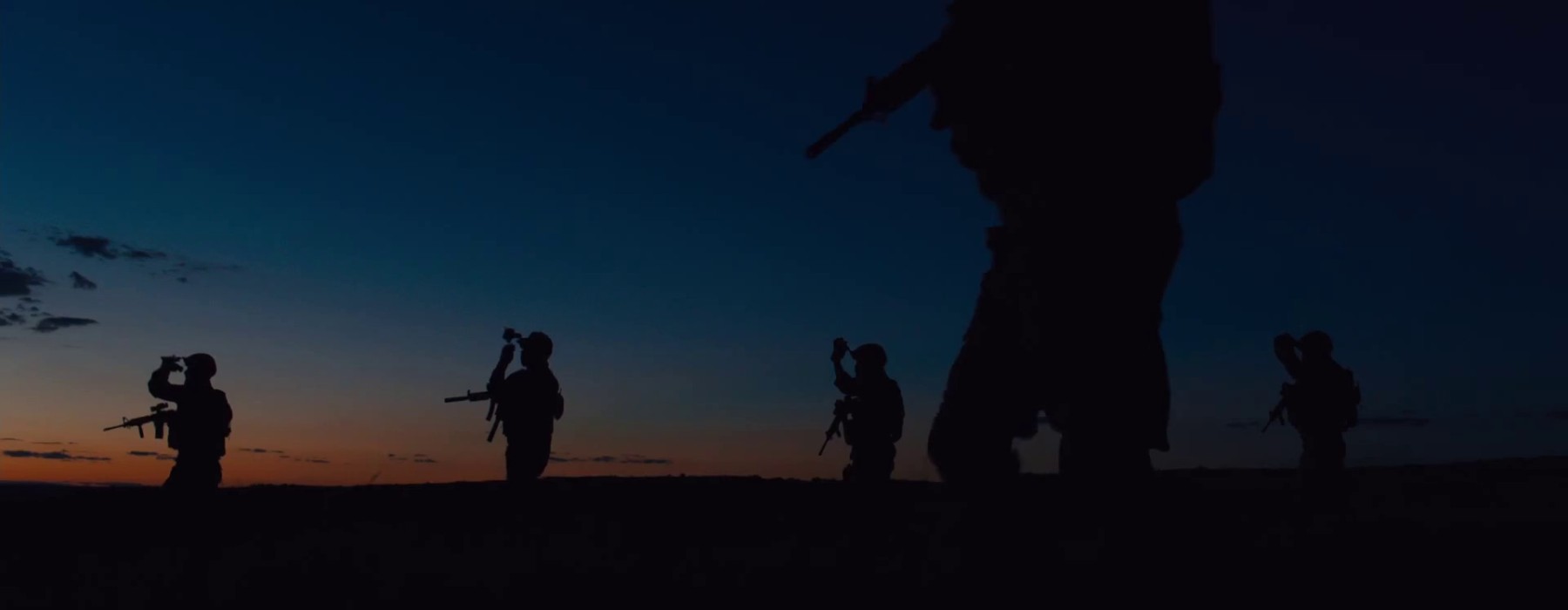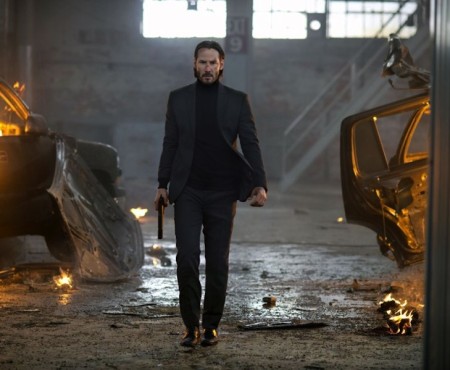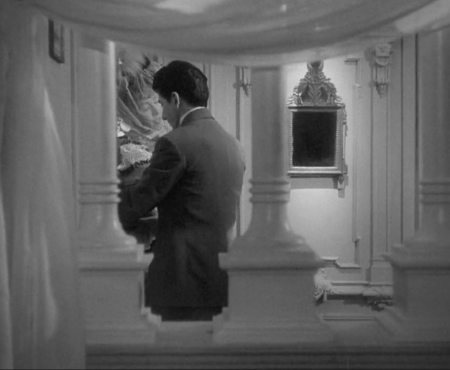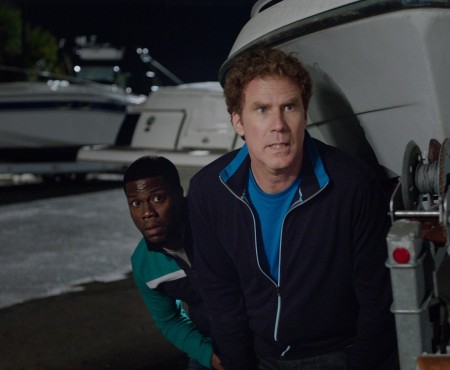38) Entertainment
In a single scene, Gregg Turkington, operating in the guise of his stage persona, Neil Hamburger, drives home Entertainment’s oblique inhumanity by repeating a single word in his signature, nasally warble: “Why? Why? Why?” Rick Alverson’s aesthetically refined, willfully amoral, and unabashedly misanthropic road trip through the American Southwest doesn’t give much away in its two-hour running time; it’s an intangible oddity, a film about a despondent comedian slogging his way from one dive bar to the next, occasionally stopping to perform in prisons or take in a chromotherapy session for reasons that are never made fully clear. That might not sound like entertainment to most, but somehow the movie’s enigmatic repugnance proves alluring rather than revolting. —Andy Crump
37) The End of the Tour
The virtues of The End of the Tour arise from script and performers collectively refusing to deify David Foster Wallace. Based on a real-life extended interview of Wallace by journalist David Lipsky (portrayed by Jesse Eisenberg as a believably immature star fucker), the film is neither road trip nor hero worship. Jason Segel’s rightly praised performance as Wallace chooses sincerity over mimicry and emerges as something far more human and sad. These two men talk and talk until, somewhere along the way, director James Ponsoldt transcends themes of fame and success and delivers an uncommonly honest portrayal of mental illness and recovery. —Adam W. Hofbauer
36) A Pigeon Sat on a Bench Reflecting on Existence
Like an episode of America’s Funniest Home Videos set inside an existential black hole, the concluding third of Swedish absurdist Roy Andersson’s “Living trilogy” brings another collection of darkly comic sketches to the filmmaker’s small but devoted fanbase. In this installment, Napoleon stops for a beer on his way to world domination, a pair of deadened gag salesmen contemplate the void, and a cafeteria worker figures a hot lunch shouldn’t go to waste just because the man who purchased it moments before has died. About a half hour in, your tears of laughter become indistinguishable from your tears of despair. —Charles Bramesco
35) The Assassin
If you can’t wrap your brain around the concept of Taiwanese legend Hou Hsiao-Hsien making a wuxia film, that’s okay: The Assassin, his first feature film since 2008’s Flight of the Red Balloon, maintains all of Hou’s normal directorial tics, even in a setting so far outside his usual comfort zone. The film recounts a Tang Dynasty legend about a girl trained as—surprise!—an assassin in her youth and commanded to kill her own cousin in the story’s present. Hou quietly saps The Assassin of the fantastic, leaving a small reserve of mysticism behind as he hones in on human drama and existential musings through an exquisite sense of craft. —Andy Crump
34) Sicario
It’s fitting that the protagonist of Sicario is a woman surrounded by men. In this slow-burn thriller, director Denis Villeneuve masterfully presents the war on drugs—and the war on terror—as analogous to rape, a form of systemic violence built on domination and consent. Foreign policy enacted at gunpoint is its own sinister form of objectification, the film argues, and it just might be the foundation of our entire way of life. Emily Blunt delivers a powerful performance as a woman slowly descending into moral hell, but there’s an even more provocative suggestion lurking on the edges of the frame: that perhaps this is the lesser of two evils. —Andrew Johnson
33) Jauja
Argentinean director Lisandro Alonso’s Jauja, shot in a 1.33:1 aspect ratio as if glimpsed through an Edisonian viewing device, lopes along like a slow-cinema version of The Revenant smuggled in from one universe over. At its center is the best male performance of the year, by an unrecognizable Viggo Mortensen, who vanishes into every inch of an emasculated Dutch explorer in 19th-century Patagonia. In yet another year where “best” is often used when people really mean “most,” this taciturn oddity prioritizes the inexplicable over the epic and emerges as one of the most satisfyingly beguiling films in years. —Adam W. Hofbauer
32) Girlhood
Céline Sciamma’s Girlhood captures the “choreography of friendship” in the dance, social performance, violence and budding affection of four working-class teen girls in the suburbs of Paris. But why aren’t Karidja Touré or any of the young actresses at the film’s center the new go-to girls for international cinema? Do they not want to act in any more films? Are they cool with bit parts in French television? If they were white, would they be all over magazine covers? They have Twitter accounts. Can someone who speaks French ask them? Anyway, this movie is great. —Adam W. Hofbauer
31) Experimenter
Famed social psychologist Stanley Milgram is here to tell us about his life and work. Some of what his experiments suggest about human nature is rather horrifying, but Experimenter makes sure to maintain a genial tone. And by the time an elephant strolls through a hallway or blatantly fake rear-projected backgrounds appear, suspicion arises that perhaps the viewer is the subject of a different kind of experiment. What better way to explore how people can be manipulated through the most overtly manipulative art form? Whatever comes to your mind when you think of a biopic about a scientist, this film most assuredly is not that. —Dan Schindel
30) Tom at the Farm
Though the meaning and worth of “Hitchcockian” has been obfuscated by overuse, it takes a uniquely skilled director and/or film for that term to be truly applicable. Mourning the loss of his lover, Tom (writer/director/star Xavier Dolan) scrawls, “Now all I can do without you is replace you.” It’s not just the tension that’s built from these words that qualifies as Hitchcockian; it’s the perversity of it all. As Tom and the brother of his late lover Francis (Pierre-Yves Cardinal) attempt to replace the same person, they perform a tango imbued with eroticism, abuse, and persona-swapping. The most restrained of the young Quebecois director’s films, Tom at the Farm uses the erotic appeal of incestuous desire and replacement as its primary catalyst of suspense. — Kyle Turner
29) In Jackson Heights
Frederick Wiseman could never be satisfied with slice-of-life documentary filmmaking, because he’s always after the whole damn cake. Every piece is meticulously sliced and put on display, respectively, in no particular order. In the Queens, N.Y., neighborhood of Jackson Heights, Wiseman finds one of the most diverse communities in the world, one that’s proud of its multicultural legacy and fighting to ward off creeping gentrification. By seamlessly bouncing from a variety of scenes, like a gay and transgender group meeting, to an Arabic-language school, to a taxi-driving class, the film’s three-hour runtime manages to feel brisk yet immensely saturated with anthropological detail, the smallest and seemingly insignificant of which will linger in one’s mind long after the film is done. — Tina Hassannia
28) It Follows
Following his feature directorial debut The Myth of the American Sleepover, David Robert Mitchell tackles teen angst once more with his stylish horror flick It Follows. Establishing a sharp metaphor within a narrative that at once challenges and breaks down the sexual tropes of the genre, Mitchell uses a staggeringly original and timeless visual language to accentuate and confront relatable troubles and terrors of adolescence. Maika Monroe delivers an effectively distressing performance as a teen hunted by an unforgiving and invisible being, heightened by the moody surroundings of a run-down Detroit and an equally nerve-racking score by Rich Vreeland (as Disasterpeace). —Tomris Laffly
27) The Big Short
Who better to tell the story of the housing crisis of the late 2000s than the director of Anchorman and Step Brothers? Adam McKay may be an unlikely candidate to helm this story of a disparate group of businessmen who separately realize the bubble’s about to burst; that’s part of what makes the film so special. Its jittery visual style, extreme self-awareness, and balance of aggro humor and aghast fury at American bankers’ arrogance combine for a fierce and unexpectedly rollicking polemic at a financial culture that’s not remotely close to being fixed. —Josh Spiegel
26) Heaven Knows What
How can you make a movie about homeless heroin addicts without stooping into exploitative miserabilism? Well, it helps to cast a former homeless heroin addict in a film based on her own memoirs. It also helps to allay the realist aspect by playing out as a dual love story—a tempestuous romance both between two people and between themselves and drugs. Or perhaps it’s a ménage à trois. Heaven Knows What is the most harrowing American film of the year, existing in the doorways and stairwells we pointedly avert our eyes from as we walk down the street. —Dan Schindel


































4 thoughts on “The 50 Best Movies of 2015”
Pingback: Best Films of 2015 lists (updating) | Under the Skin
Great list guys.
Pingback: From Our Members’ Desks (Jan. 19, 2016) – Online Film Critics Society
Pingback: In Praise of Roger Deakins | WFUmediaphiles